它來了它來了,!25年最亮的一顆彗星來了,錯過再等6800年
太空來客Neowise彗星本月造訪地球,,讓天文觀測者目眩神迷,。
這是近25年來最亮的一顆彗星,北半球一直到8月中旬都可以看到,。這顆來自外太空的天體將于7月23日抵達離地球最近的位置,,距地球僅6400萬英里,和水星離地球的平均距離大致相當,。
它的官方名字是C/2020 F3 (NEOWISE),,人們用肉眼就可以看到它出現(xiàn)在天空的西北部。它就位于大熊座下方,,一整個晚上都能看到,。
之后的每天晚上,彗星會在天空中越升越高,,直到最終從人們的視野中消失,。等到它重返地球,估計要到6800年后了,。
除了夜間,,早起的人暫時也能看到Neowise彗星。在日出前一小時向東北方向看,,可以看到它拖著尾巴的痕跡,,接下來幾天,,它會滑到地平線以下,,消失在人們視線之外,。
訪問美國國家航空和航天局官網(wǎng)(NASA.gov)或《天空和望遠鏡》雜志(Sky & Telescope),即可獲得更多觀測細節(jié),。還可以登陸一個由NASA志愿者開發(fā)的在線應(yīng)用程序,,輸入自己的位置,確定最佳觀看時機,。
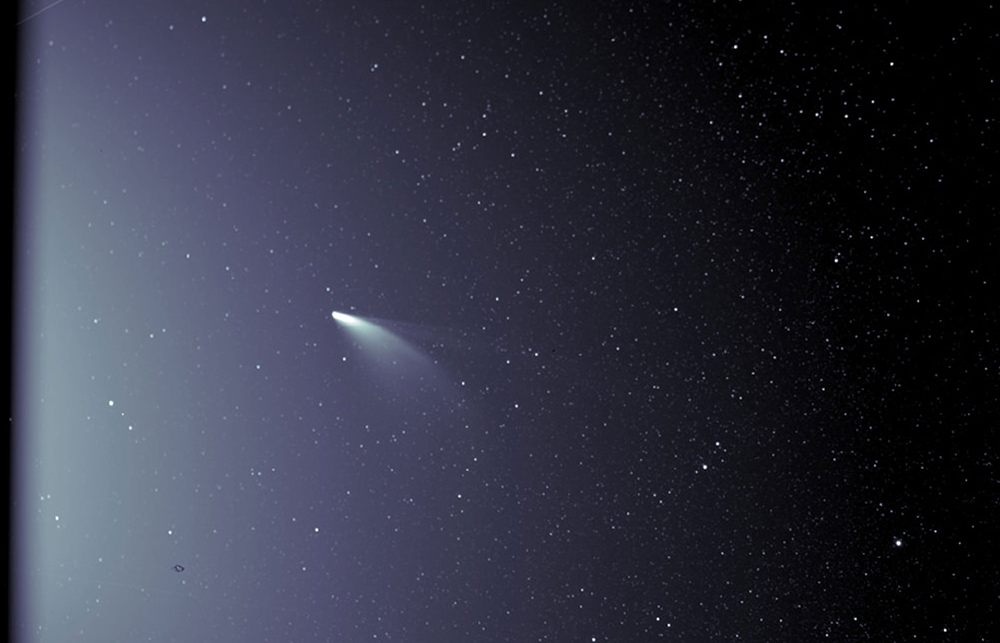
我們對Neowise彗星了解多少?
Neowise是一個布滿塵埃的冰球,,它不斷高速飛行,,和太陽系一樣古老,已經(jīng)46億歲了,。
這條3英里長的太空冰柱被認為起源于外層空間一個叫做奧爾特云的區(qū)域,。這片云是行星形成時遺留下來的冰凍巖石碎片的墓地,存在時間遠遠超過了海王星和冥王星的軌道,。
盡管Neowise很古老,,但它直到最近才被科學(xué)家發(fā)現(xiàn)。3月27日,,NASA的天文學(xué)家通過太空望遠鏡發(fā)現(xiàn)了這顆雪球,,用的望遠鏡也叫NEOWISE,和彗星同名,。(NEOWISE是近地天體寬視場紅外勘測探測器的首字母縮寫,。)
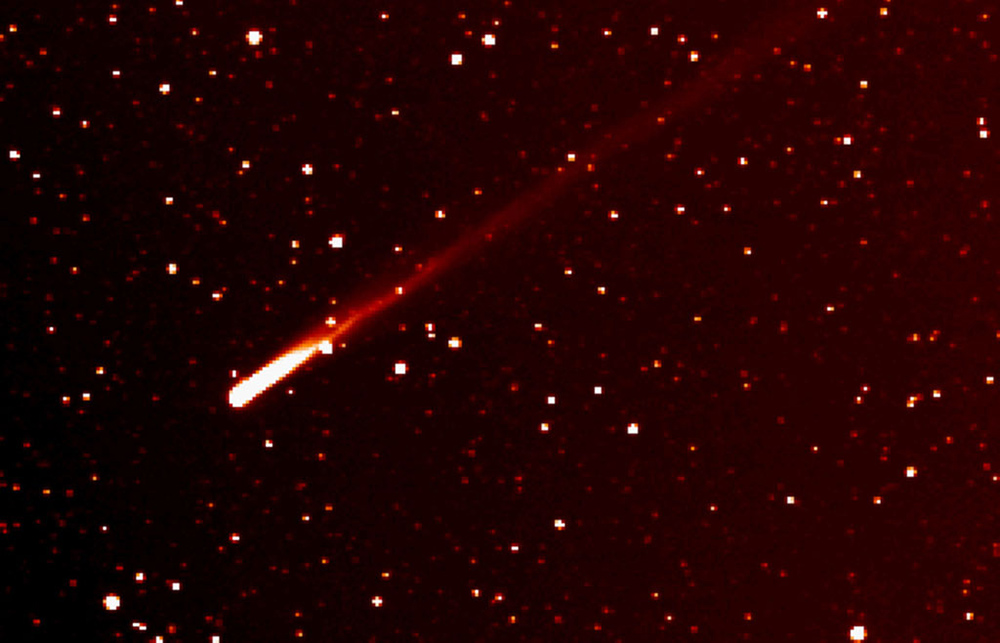
6月,從NASA的日地關(guān)系觀測臺(STEREO)觀測彗星Neowise,。
NASA使用NEOWISE望遠鏡搜尋可能危及地球的天體,。比如,??颂K魯伯小行星(按照撞擊地今天在墨西哥的地名來命名)被認為在6500萬年前撞擊了地球,,導(dǎo)致恐龍滅絕。
“我們希望,,遠在Neowise彗星這樣的天體還沒有接近地球時就能發(fā)現(xiàn)它們,。”NEOWISE項目的首席研究員,、亞利桑那大學(xué)的行星科學(xué)教授艾米?邁因策爾在給《財富》雜志的電子郵件中表示,。她說,這顆彗星“非常大,,大約和導(dǎo)致恐龍滅絕的那顆行星一樣大”,,但幸運的是,,它“不會造成危險”。
科學(xué)家們希望通過研究像Neowise這樣的彗星,,了解更多關(guān)于太陽系起源的信息,,同時避免可能出現(xiàn)的物種滅絕?!拔覀冃枰厘缧呛托⌒行鞘怯墒裁唇M成的,,知道它們有多易碎或者多牢固——如果有一天我們不得不把哪顆星星推離軌道的話?!边~因策爾說,。
這顆彗星長什么樣?
對肉眼來說,,Neowise就像一顆模糊的星星劃過天空,。
這顆彗星的亮度將和附近的北斗七星差不多,北斗七星也被稱為大熊星座,。雖然并非必須,,但一副雙筒望遠鏡或望遠鏡能夠提升觀測體驗。
就連天文學(xué)家觀測時也充滿敬畏,?!坝捎谖覀儗@些行星的搜索,得以看到一些非常美麗的存在,,它們提醒我們與更廣闊的宇宙之間的聯(lián)系,。” 邁因策爾說,。
Neowise和大多數(shù)彗星一樣,,拖著兩條延伸數(shù)百萬英里的彗尾。第一條由塵埃碎片組成,,由于反射陽光而發(fā)出金色的光芒,。第二條尾巴由被太陽輻射撞擊造成的帶電氣體粒子組成,向左邊發(fā)出微弱的藍光,。
上一次從地球上看到彗星發(fā)出如此強烈的光芒還要追溯到上世紀90年代中期的海爾-波普彗星,。
“天堂之門”(Heaven’s Gate)邪教的39名成員在這次天文事件期間于圣迭戈郊區(qū)集體自殺,鬧得沸沸揚揚,。他們相信這樣做可以讓他們搭上伴飛的外星飛船,。
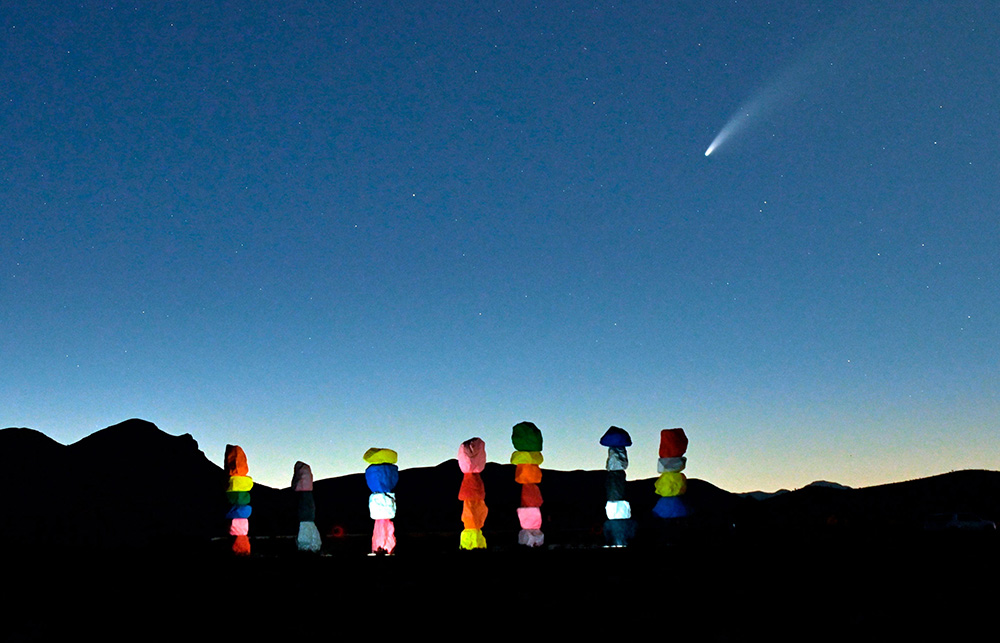
Neowise彗星的照片
Neowise在7月3日最接近太陽,。在地球引力彈弓的推動下,這顆彗星正在向外太空回擺。
與Neowise不同的是,,大多數(shù)彗星并不會呈現(xiàn)壯觀的景象,。今年早些時候還發(fā)現(xiàn)了ATLAS彗星和SWAN彗星,但它們都在自己的太空之旅中熄了火,。
而最著名的哈雷彗星則是個特例,。它是已知唯一一顆在生命周期中確定可以被短暫觀測到的彗星。(請在你的日歷上記下哈雷彗星下一次出現(xiàn)的時間:2061年7月28日,。)
更常見的情況是,,彗星無法預(yù)測,、反復(fù)無常,;我們無法確切知道下一顆彗星會在什么時候出現(xiàn)。因此,,攝影師和天文學(xué)家都迫不及待地抓住機會,,想要在Neowise的短暫逗留中捕捉它的美麗。
以下是我們最喜歡的一些圖片示例,。
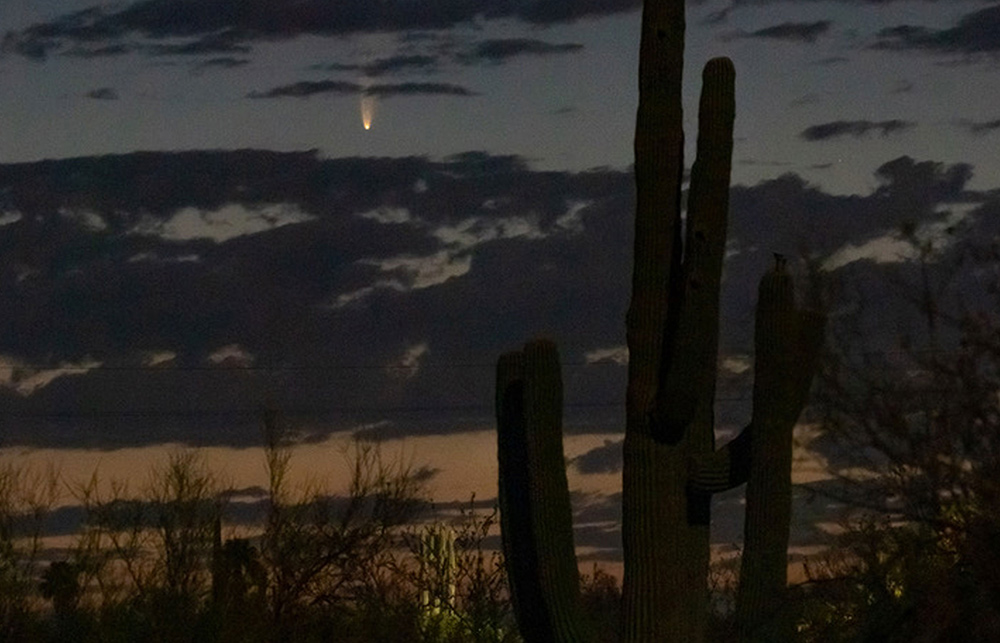
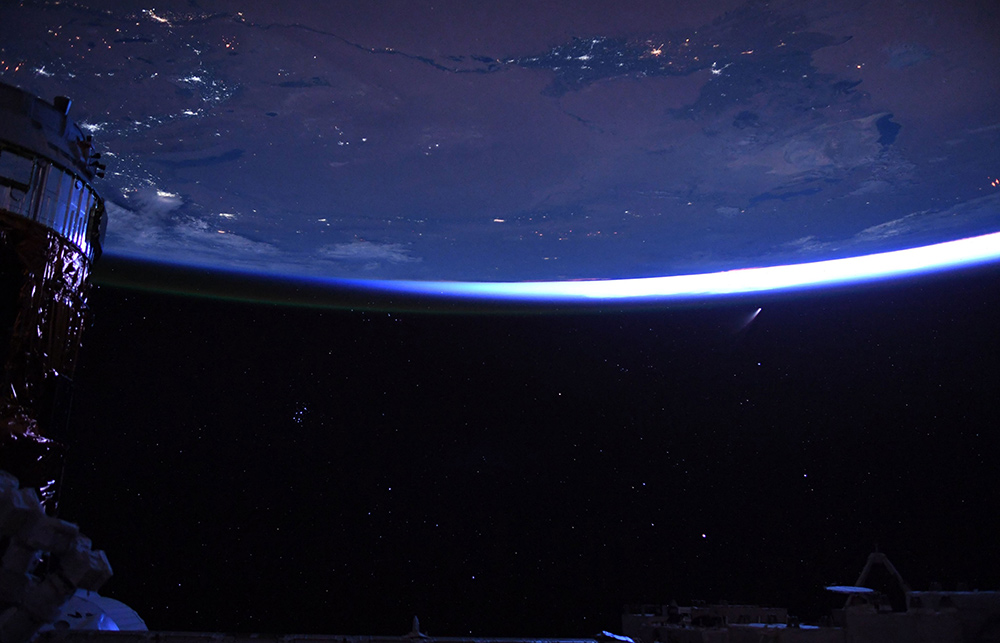

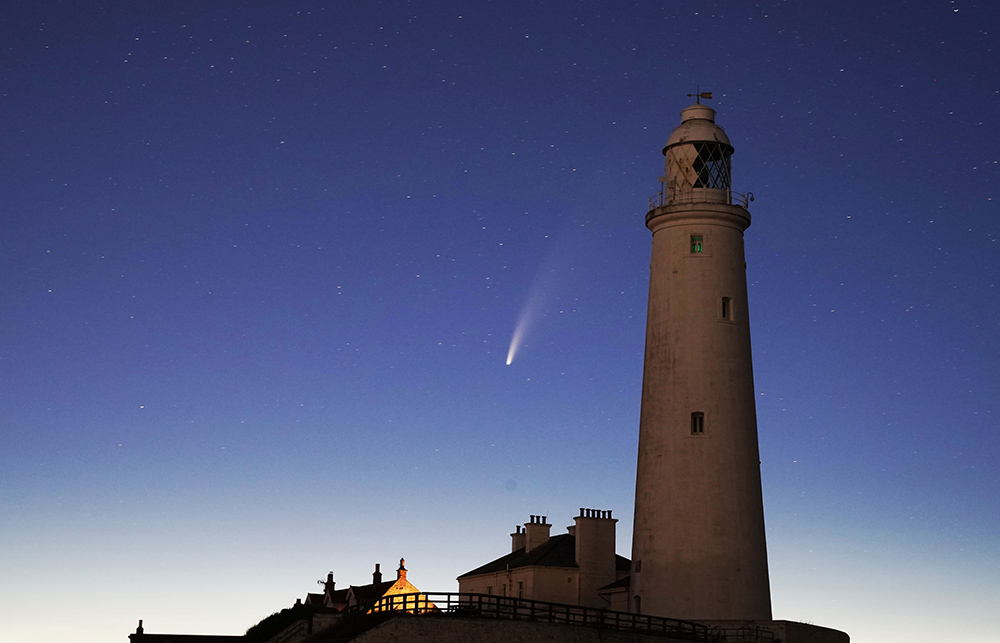

(財富中文網(wǎng))
譯者:Agatha
太空來客Neowise彗星本月造訪地球,讓天文觀測者目眩神迷,。
這是近25年來最亮的一顆彗星,,北半球一直到8月中旬都可以看到。這顆來自外太空的天體將于7月23日抵達離地球最近的位置,,距地球僅6400萬英里,,和水星離地球的平均距離大致相當。
它的官方名字是C/2020 F3 (NEOWISE),,人們用肉眼就可以看到它出現(xiàn)在天空的西北部,。它就位于大熊座下方,一整個晚上都能看到。
之后的每天晚上,,彗星會在天空中越升越高,,直到最終從人們的視野中消失。等到它重返地球,,估計要到6800年后了,。
除了夜間,早起的人暫時也能看到Neowise彗星,。在日出前一小時向東北方向看,,可以看到它拖著尾巴的痕跡,接下來幾天,,它會滑到地平線以下,,消失在人們視線之外。
訪問美國國家航空和航天局官網(wǎng)(NASA.gov)或《天空和望遠鏡》雜志(Sky & Telescope),,即可獲得更多觀測細節(jié),。還可以登陸一個由NASA志愿者開發(fā)的在線應(yīng)用程序,輸入自己的位置,,確定最佳觀看時機,。
7月5日的Neowise彗星,此時距它離太陽最近才過去不久,。
我們對Neowise彗星了解多少?
Neowise是一個布滿塵埃的冰球,,它不斷高速飛行,和太陽系一樣古老,,已經(jīng)46億歲了,。
這條3英里長的太空冰柱被認為起源于外層空間一個叫做奧爾特云的區(qū)域。這片云是行星形成時遺留下來的冰凍巖石碎片的墓地,,存在時間遠遠超過了海王星和冥王星的軌道,。
盡管Neowise很古老,但它直到最近才被科學(xué)家發(fā)現(xiàn),。3月27日,,NASA的天文學(xué)家通過太空望遠鏡發(fā)現(xiàn)了這顆雪球,用的望遠鏡也叫NEOWISE,,和彗星同名,。(NEOWISE是近地天體寬視場紅外勘測探測器的首字母縮寫。)
6月,,從NASA的日地關(guān)系觀測臺(STEREO)觀測彗星Neowise,。
NASA使用NEOWISE望遠鏡搜尋可能危及地球的天體。比如,,??颂K魯伯小行星(按照撞擊地今天在墨西哥的地名來命名)被認為在6500萬年前撞擊了地球,導(dǎo)致恐龍滅絕。
“我們希望,,遠在Neowise彗星這樣的天體還沒有接近地球時就能發(fā)現(xiàn)它們,。”NEOWISE項目的首席研究員,、亞利桑那大學(xué)的行星科學(xué)教授艾米?邁因策爾在給《財富》雜志的電子郵件中表示,。她說,這顆彗星“非常大,,大約和導(dǎo)致恐龍滅絕的那顆行星一樣大”,,但幸運的是,它“不會造成危險”,。
科學(xué)家們希望通過研究像Neowise這樣的彗星,,了解更多關(guān)于太陽系起源的信息,同時避免可能出現(xiàn)的物種滅絕,?!拔覀冃枰厘缧呛托⌒行鞘怯墒裁唇M成的,,知道它們有多易碎或者多牢固——如果有一天我們不得不把哪顆星星推離軌道的話,。”邁因策爾說,。
這顆彗星長什么樣,?
對肉眼來說,Neowise就像一顆模糊的星星劃過天空,。
這顆彗星的亮度將和附近的北斗七星差不多,,北斗七星也被稱為大熊星座。雖然并非必須,,但一副雙筒望遠鏡或望遠鏡能夠提升觀測體驗,。
就連天文學(xué)家觀測時也充滿敬畏?!坝捎谖覀儗@些行星的搜索,,得以看到一些非常美麗的存在,它們提醒我們與更廣闊的宇宙之間的聯(lián)系,?!?邁因策爾說。
Neowise和大多數(shù)彗星一樣,,拖著兩條延伸數(shù)百萬英里的彗尾,。第一條由塵埃碎片組成,由于反射陽光而發(fā)出金色的光芒,。第二條尾巴由被太陽輻射撞擊造成的帶電氣體粒子組成,,向左邊發(fā)出微弱的藍光。
上一次從地球上看到彗星發(fā)出如此強烈的光芒還要追溯到上世紀90年代中期的海爾-波普彗星。
“天堂之門”(Heaven’s Gate)邪教的39名成員在這次天文事件期間于圣迭戈郊區(qū)集體自殺,,鬧得沸沸揚揚,。他們相信這樣做可以讓他們搭上伴飛的外星飛船。
內(nèi)華達州拉斯維加斯南部,,Neowise彗星出現(xiàn)在藝術(shù)家烏戈?羅迪納打造的“七魔山”(Seven Magic Mountains)藝術(shù)裝置上方,。
Neowise彗星的照片
Neowise在7月3日最接近太陽。在地球引力彈弓的推動下,,這顆彗星正在向外太空回擺,。
與Neowise不同的是,大多數(shù)彗星并不會呈現(xiàn)壯觀的景象,。今年早些時候還發(fā)現(xiàn)了ATLAS彗星和SWAN彗星,,但它們都在自己的太空之旅中熄了火。
而最著名的哈雷彗星則是個特例,。它是已知唯一一顆在生命周期中確定可以被短暫觀測到的彗星,。(請在你的日歷上記下哈雷彗星下一次出現(xiàn)的時間:2061年7月28日。)
更常見的情況是,,彗星無法預(yù)測,、反復(fù)無常;我們無法確切知道下一顆彗星會在什么時候出現(xiàn),。因此,,攝影師和天文學(xué)家都迫不及待地抓住機會,想要在Neowise的短暫逗留中捕捉它的美麗,。
以下是我們最喜歡的一些圖片示例,。
7月6日,圖森,,日出前東北地平線上的Neowise彗星,。
7月9日,宇航員羅伯特?本肯在國際空間站捕捉到了Neowise彗星,。
7月11日,,意大利莫菲塔,Neowise彗星在夕陽下閃耀,。
7月14日凌晨,,Neowise彗星經(jīng)過英國惠特利灣的圣瑪麗燈塔。
7月15日,,法國南部圣米歇爾天文臺,,Neowise彗星經(jīng)過一座古老風(fēng)車的上方。
(財富中文網(wǎng))
譯者:Agatha
A space-born visitor, the Neowise comet, is dazzling skygazers this month.
The brightest comet to grace our skies in nearly a quarter century is visible in the Northern Hemisphere through mid-August. The celestial guest will make its closest approach to Earth on July 23 at a distance of 64 million miles—about equal to Mercury's average distance from Earth.
People can view the comet, officially, C/2020 F3 (NEOWISE)—with the naked eye in the northwest skies. The comet will appear all night under the Big Dipper constellation.
Each evening the comet climbs higher in the sky until eventually it fades from view. The space-rock is expected to return again in 6,800 years.
In addition to its nighttime show, Neowise is temporarily visible for early risers in the morning too. Look to the northeast about an hour before sunrise for the telltale trailing tail, which will slip beneath the horizon and out of view in the coming days.
Visit NASA.gov for additional observational details, or Sky & Telescope magazine. People can also enter their locations into a helpful online app developed by a NASA volunteer to determine the best viewing opportunities.
What do we know about the Neowise comet?
Neowise is a hurtling, dusty ball of ice that's as old as the solar system at 4.6 billion-years old.
The 3-mile-long space icicle is believed to have originated in a region of outer space called the Oort Cloud. The cloud is a graveyard of frozen rocky fragments leftover from the formation of the planets, and it exists far past the orbits of Neptune and Pluto.
Despite its age, scientists discovered Neowise only very recently. NASA astronomers detected the snowball on March 27 using a space telescope, also called NEOWISE, the comet's namesake. (The name stands for Near-Earth Object Wide-field Infrared Survey Explorer.)
NASA uses NEOWISE, the telescope, to hunt for celestial objects that could endanger Earth. One such missile—the Chicxulub impactor, named for its collision site in present-day Mexico—is believed to have annihilated the dinosaurs 65 million years ago.
"We want to spot objects like Comet Neowise well before they can make any close approaches," Amy Mainzer, principal investigator for the NEOWISE project and professor of planetary sciences at the University of Arizona, said in an email to Fortune. She notes that this one is "very large, about as big as the object that wiped out the dinosaurs," but that it fortunately "poses no hazard."
By studying comets like Neowise, scientists hope to learn more about the solar system's origins—and avoid potential extinction "We need to know what comets and asteroids are made of and how crumbly they are—or solid—if we ever have to push one out of the way," Mainzer says.
What does the comet look like?
To the naked eye, Neowise will appear as a fuzzy star streaking across the sky.
The comet will be about as bright as the stars appearing close by in the Big Dipper, a constellation also known as Ursa Major, or the Great Bear. While not required, a pair of binoculars or a telescope will enhance the view.
Even astronomers look on in awe. "As a byproduct of these searches, we get to see something really beautiful that reminds us of our connection to the larger universe.," Mainzer says.
Neowise, like most comets, has two tails that extend for millions of miles. The first, made of dusty debris, shines golden as it reflects sunlight. The second tail, made of electrically charged gas particles blasted by solar radiation, glows faintly blue toward the left.
The last time a comet blazed this intensely from our earthly vantage point was during the Hale-Bopp Comet's visitation in the mid-'90s.
Infamously, 39 members of the Heaven's Gate cult committed ritual suicide in a San Diego suburb during the astronomical event. They believed doing so would enable them to hitch a ride on an accompanying extraterrestrial spacecraft.
Photos of the Neowise comet
Neowise made its closest approach to the sun on July 3. The comet is now swinging back out into space, propelled by our star's gravitational slingshot.
Unlike Neowise, most comets present no spectacular show. Comet ATLAS and Comet SWAN, also discovered earlier this year, fizzled out during their cosmic circuits.
The most famous comet, Halley's, is an anomaly. It is the only known, reliably visible comet with a short enough period to be witnessed in the span of a lifetime. (Mark your calendar for the next appearance: July 28, 2061.)
More commonly, comets are unpredictable and capricious; there's no knowing exactly when the next one will gleam. So photographers and astronomers of all stripes are jumping at the opportunity to capture the beauty of Neowise's sojourn.
Here is a sampling of our favorites.













